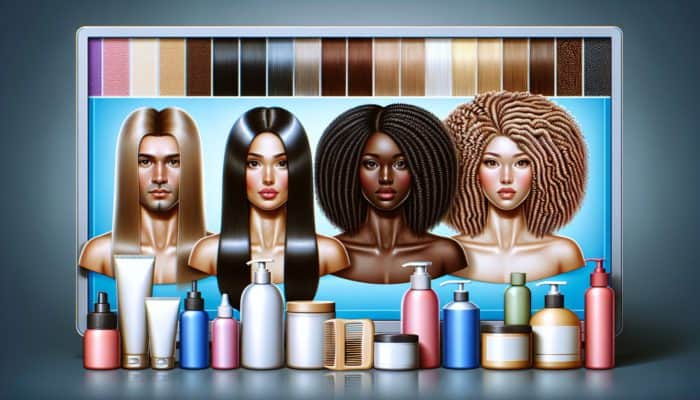Discover How to Understand and Cater to Your Hair's Unique Requirements
To excel in the complex journey of achieving the perfect balance of moisture and protein in your hair, it is essential to delve into the specific needs that your hair possesses. Each person's hair is unique, showcasing distinct characteristics that dictate tailored care routines and product selections. By accurately identifying your personal hair type, you can make well-informed decisions regarding the products you choose and the routines you develop. This knowledge ultimately leads to healthier, more vibrant strands that reflect your unique style and the dedication you apply to your hair care regimen.
Identify Your Hair Type: A Crucial Step Towards Achieving Healthier Hair

To effectively nurture your hair's health, the first step is to accurately ascertain your hair type. Hair is generally classified into four primary types: straight, wavy, curly, and coily, each possessing unique features that dictate their specific moisture and protein requirements. For example, straight hair usually tends to be oilier, which may require less moisture; however, it still benefits from protein to prevent breakage and maintain structural strength. On the other hand, curlier textures typically demand more hydration, as the natural oils struggle to travel down the hair shaft, making it essential to tailor your hair care routine accordingly to ensure optimal health.
Furthermore, it is imperative to evaluate the porosity of your hair, which refers to its ability to absorb moisture and products effectively. Low-porosity hair often resists moisture, necessitating lighter formulations that will not weigh down the strands. In contrast, high-porosity hair absorbs moisture easily but struggles with retention, often resulting in dryness. Understanding these characteristics empowers you to customise your hair care regimen effectively, ensuring a harmonious balance of both moisture and protein that aligns with your specific hair type.
Recognising Signs of Imbalance in Moisture and Protein Levels
Being adept at identifying the signs of an imbalance in your hair's moisture and protein levels is vital for maintaining optimal hair health. An excess of moisture can lead to weak, limp hair that feels overly soft and lacks definition, resulting in strands that stretch excessively or break easily when tugged. Conversely, an overload of protein can cause hair to become dry and brittle, snapping under minimal stress, leading to a rough texture that is challenging to style and manage effectively.
Pay attention to specific symptoms: if your hair feels gummy or overly stretchy, it may be signalling a need for protein. Conversely, if your hair appears dry and frizzy despite regular attempts at hydration, it likely craves additional moisture. By remaining aware of these indicators, you can make timely adjustments to your hair care routine, ultimately fostering optimal health and vibrancy in the long run.
Regularly Reviewing Your Hair Care Routine for Continuous Improvement
Consistent evaluations are paramount in your quest to achieve the perfect balance of moisture and protein. Regularly reassessing your hair care regimen is crucial for determining its effectiveness in meeting your hair's evolving requirements. This process may involve altering products based on environmental conditions, seasonal changes, or shifts in your hair's texture or overall health, ensuring that you are always providing your hair with the best possible care tailored to its current state.
A beneficial practice is to document your hair's responses to various products and routines. This proactive strategy not only aids in understanding how your hair reacts to different treatments but also empowers you to adjust your routine as necessary to maintain balance. By conducting regular evaluations, you can efficiently manage your hair's immediate needs while fostering long-term health and vitality within each strand.
Choosing Moisture-Rich Products for Enhanced Hair Health

The journey towards achieving a harmonious balance of moisture and protein begins with selecting suitable products. Opting for moisture-rich formulations can significantly enhance your hair's overall health, ensuring it remains well-hydrated and resilient against environmental stressors and styling practices that may compromise its integrity over time.
How to Select the Perfect Conditioner for Your Hair Type
Choosing the right conditioner is crucial in your efforts to maintain optimal moisture levels for your hair. Look for conditioners that promise deep hydration without weighing your hair down. Key ingredients such as glycerin, hyaluronic acid, and aloe vera are exemplary for moisture retention, as they work to attract and bind water to the hair, cultivating softness and shine.
Additionally, consider conditioners specifically labelled as ‘moisture-rich’ or ‘hydrating,’ designed to cater to your hair type's needs. For instance, if you have curly or coily hair, choose a thicker, creamier formula that delivers intensive moisture while beautifully defining your curls. Conversely, finer hair types should seek lightweight conditioners that provide hydration without heaviness, ensuring the right balance. The ideal conditioner not only enhances your hair's moisture content but also establishes a protective barrier against environmental stressors that could compromise its health over time.
The Advantages of Integrating Leave-In Treatments into Your Hair Care Regimen
Incorporating leave-in treatments into your hair care routine provides a continuous supply of moisture throughout the day, making these products invaluable additions. Unlike traditional conditioners, leave-in products are designed to be applied after washing and left in the hair without rinsing. These treatments deliver an extra layer of hydration, serving as a fantastic ally in the ongoing battle against dryness.
Leave-in treatments are particularly beneficial in arid climates where moisture loss occurs rapidly. Richly formulated with humectants and oils, these products work to seal in hydration, ensuring your hair remains plump and healthy. Regular use of leave-in conditioners can enhance manageability, reduce frizz, and improve your hair's overall appearance. Furthermore, they act as a protective shield against heat styling tools and environmental pollutants, making them essential components in your hair care arsenal.
Enhancing Moisture Levels with Natural Oils and Butters

Incorporating natural oils and butters into your hair care routine is a time-honoured strategy for significantly enhancing moisture levels. Oils such as argan, jojoba, and coconut are rich in essential fatty acids and vitamins that nourish and hydrate the hair effectively. These natural ingredients offer the remarkable ability to penetrate the hair shaft, providing deep nourishment and protection against damage, making them ideal for every hair type.
Butters, including shea and mango, provide a rich, emollient layer that efficiently locks in moisture. They are particularly beneficial for thick, coarse, or textured hair, which often requires heavier products to maintain hydration. By integrating these components into your hair regimen, you can dramatically improve moisture retention, resulting in softer, more manageable hair that appears revitalised and healthy.
The Remarkable Benefits of Hydrating Masks and Treatments
Applying hydrating masks and treatments on a weekly basis can significantly elevate your hair’s moisture balance. These intensive treatments are specifically crafted to penetrate deeply into the hair shaft, delivering a surge of hydration and essential nutrients. Seek masks that boast hydrating ingredients such as honey, aloe vera, and various botanical extracts to effectively nourish your hair.
Integrating a hydrating mask into your routine should ideally occur once a week to restore moisture levels and repair any damage. These treatments can replenish lost moisture caused by environmental factors, heat styling, or chemical processes, ensuring your hair remains healthy and vibrant. Investing time in these treatments not only revitalises your hair but can also enhance its texture, appearance, and overall health, allowing you to achieve the luscious locks you've always desired.
Understanding the Importance of Protein Treatments for Optimal Hair Health
Protein treatments serve as a crucial counterbalance to moisture, particularly for hair that has undergone damage or excessive treatment. Recognising when and how to effectively implement these treatments can help maintain your hair's integrity, ensuring it remains strong and resilient under various conditions.
Recognising When to Implement Protein Treatments
Determining the appropriate frequency of protein treatments is essential for achieving optimal hair health. The general guideline suggests using protein treatments every four to six weeks; however, this may vary based on your hair's specific condition. Signs that indicate your hair is in need of protein include excessive elasticity, where it stretches too much without returning to its original state, and visible breakage.
Consider the overall health of your hair: if it has been subjected to chemical processes, heat styling, or other environmental stressors, it may benefit from more frequent protein applications. However, for hair that remains relatively healthy, less frequent treatments may suffice. Monitoring your hair’s response to these treatments is vital, allowing you to adjust the frequency as necessary to maintain the best balance and health.
Exploring the Various Types of Protein Treatments Available
Exploring the different types of protein treatments on the market can help you select the most suitable option for your hair type. Hydrolysed proteins, including keratin, silk, and wheat protein, are popular choices due to their ability to penetrate the hair shaft effectively and strengthen its structure.
Each type of protein offers unique benefits: keratin helps to fortify and smooth the hair, while silk protein enhances shine and softness. Among the myriad of products available, choose one that aligns with your hair's specific needs. For example, if your hair is fine and prone to breakage, a lightweight protein spray might be ideal, whereas thicker hair may benefit from a more robust treatment to effectively restore strength and vitality.
Avoiding Over-Proteinization for Healthy Hair
While protein is a vital component for maintaining hair health, excessive use can lead to a condition known as over-proteinization. This condition arises when hair becomes overly stiff and brittle due to an excess of protein, ultimately resulting in breakage and damage.
To prevent this issue, closely monitor your hair’s texture and response to treatments. If your hair feels excessively dry or hard following a protein treatment, it may be time to reduce the frequency of protein applications. Balancing protein with adequate moisture is essential; treatments should never be applied in isolation. Incorporate hydrating products alongside protein treatments to ensure your hair remains resilient, soft, and healthy, striking the ideal balance between moisture and protein.
Effective Approaches to Achieving the Perfect Moisture and Protein Balance
Achieving the ideal balance between moisture and protein necessitates a thoughtful and strategic approach. By implementing a variety of strategies, you can ensure that your hair receives the nourishment it needs to thrive and maintain its health.
Utilising Product Alternation for Balanced Hair Care
A strategic method for maintaining balance in your hair care routine involves alternating between moisture-focused and protein-focused products. For instance, if you use a protein treatment one week, follow up with a moisture-rich conditioner the next. This rotation helps prevent overloading your hair with either element, allowing it to benefit from both moisture and protein effectively.
Seek out products specifically formulated to offer a balance of moisture and protein. Many brands now provide dual-action products designed to seamlessly fit into your routine. By alternating treatments, you can maintain a dynamic approach to your hair care, ensuring your strands receive comprehensive nourishment tailored to their unique needs.
Creating Customised DIY Solutions for Hair Care
Crafting homemade treatments can also provide a balanced approach to moisture and protein that is tailored specifically for your hair. Consider combining natural ingredients such as mashed avocado (a source of healthy fats and moisture) with a bit of Greek yoghurt (rich in protein) to create a nourishing hair mask that caters to your unique needs.
Experimenting with DIY recipes allows you to customise treatments to your specific hair requirements while ensuring the use of quality, natural ingredients. This versatility is particularly beneficial for individuals with sensitivities to commercial products or those who prefer a more organic approach to hair care, ultimately enhancing the overall health and appearance of your locks.
Seeking Expert Guidance for Tailored Hair Care Solutions
Consulting with hair care professionals can provide invaluable support in effectively tailoring your hair care routine. Hair stylists and trichologists possess the expertise to analyse your hair’s needs and suggest appropriate products and treatments based on their findings. Their insights, derived from experience, equip you with the knowledge necessary to maintain balance in your hair care regimen.
Regular consultations can also help you adapt to seasonal changes or shifts in your hair’s condition, ensuring ongoing health and vitality. A professional’s perspective can be particularly beneficial when addressing specific concerns, such as damage from colour treatments, heat styling, or other environmental factors that may affect hair health.
Ongoing Monitoring for Optimal Hair Health
Regularly evaluating your hair's condition is crucial for making timely adjustments in your moisture and protein balance. Your hair can change due to numerous factors, such as diet, climate, and chemical exposure. Routine assessments will enable you to fine-tune your hair care regimen, ensuring it effectively meets your hair’s evolving needs.
Consider keeping a hair diary to document your observations and the products you’ve used. This practice can reveal patterns in your hair's response to various treatments, empowering you to make informed choices moving forward and ensuring that your hair remains in optimal condition.
Adapting Your Hair Care Routine to Seasonal Changes
As seasons change, so do the environmental effects on your hair. In humid conditions, hair may require more moisture, while dry, cold months can lead to an increased need for both protein and hydration. Modifying your hair care routine seasonally is crucial for maintaining optimal health and vibrancy throughout the year.
Incorporate richer conditioners and hydrating products during winter, while opting for lighter formulations in the summer months. Additionally, consider protective styles or treatments to shield your hair from seasonal stresses, ensuring it remains balanced and healthy year-round, regardless of climate conditions.
Key Lifestyle Factors That Influence Hair Health and Wellness
Beyond the products and treatments you utilise, your lifestyle choices play a significant role in your hair's health. Factors such as diet, environment, stress levels, and sleep all contribute to maintaining the balance of moisture and protein, directly impacting the overall health and appearance of your hair.
The Importance of a Balanced Diet and Proper Hydration for Hair Wellness
A balanced diet rich in vitamins and minerals is fundamental to optimal hair health. Incorporate foods high in omega-3 fatty acids, protein, and vitamins A, C, D, and E to support hair growth and strength. Foods such as fish, nuts, leafy greens, and fruits can provide your body with the essential nutrients it requires to nourish your hair from within.
Additionally, maintaining adequate hydration is equally crucial. Water plays a vital role in cellular function and overall health, directly impacting moisture levels in your hair. Aim to drink plenty of water daily, as this simple habit can rejuvenate your hair and promote a healthy, vibrant appearance that reflects your overall well-being.
Protecting Your Hair from Environmental Influences
Safeguarding your hair from environmental factors is essential for maintaining its moisture and protein balance. Exposure to pollution, UV rays, and harsh weather can compromise the integrity of your hair. Consider employing protective hairstyles, scarves, or UV-protective products to shield your strands from external aggressors that could lead to damage and imbalance.
Moreover, regular cleansing is necessary to eliminate buildup from environmental pollutants and styling products. Ensure you use gentle shampoos that won’t strip your hair of its natural oils while effectively removing impurities. This balance aids in maintaining moisture levels and keeping your hair healthy and vibrant.
Managing Stress for Improved Hair Health
Stress can significantly affect your hair's health, leading to issues such as hair loss and imbalances in moisture and protein levels. Engaging in stress-reducing practices, such as meditation, yoga, or regular physical activity, can promote overall well-being, positively influencing your hair health and vitality.
Finding time for self-care is vital in a hectic world. By prioritising activities that alleviate stress, you can foster a healthier mindset that directly benefits your hair and overall vitality, ensuring that you remain in tune with your body’s needs.
The Role of Quality Sleep in Promoting Hair Growth and Health
Adequate sleep is often overlooked in discussions regarding hair health; however, insufficient sleep can lead to hair loss and hinder growth. Aim for 7-9 hours of restorative sleep each night to support your body's natural repair processes, including hair growth and maintenance.
Consider establishing a bedtime routine that promotes better sleep quality. This might involve reducing screen time before bed, creating a calming ambiance, and prioritising relaxation techniques that help your body unwind. Quality sleep is a crucial factor in maintaining a healthy scalp and balanced hair, allowing your body to rejuvenate and restore itself overnight.
Enhancing Hair Health Through Consistent Exercise
Incorporating regular exercise into your lifestyle can enhance blood circulation, which is vital for nourishing hair follicles. Physical activity encourages oxygen and nutrient-rich blood to flow to the scalp, supporting hair growth and overall vitality.
Find an exercise routine that suits your lifestyle, whether it’s yoga, jogging, swimming, or weight training. The positive effects of exercise extend beyond physical health, benefitting mental well-being and stress management. Embracing this holistic approach to self-care can significantly contribute to the health and appearance of your hair, helping you maintain balance and vitality.
Essential Maintenance and Monitoring Practices for Sustaining Hair Health
Regular maintenance and monitoring of your hair is imperative for preserving its health and beauty. Establishing a consistent routine and periodically assessing your hair’s condition will ensure it remains vibrant, well-balanced, and looking its absolute best.
The Crucial Role of Regular Trims for Healthy Hair
Scheduling regular trims is a key aspect of maintaining healthy hair. Trimming the ends every six to eight weeks helps prevent split ends from travelling up the hair shaft, ultimately promoting stronger and healthier strands. This proactive measure aids in maintaining the overall integrity of your hair while ensuring it looks fresh and vibrant.
Regular trims can also enhance the overall appearance of your hair, making it look fuller and more vibrant. Regardless of length, ensuring your hair is well-shaped and free from damage is vital for maintaining its moisture and protein balance, allowing it to reflect the efforts you put into your overall hair care routine.
Monitoring Hair Health and Condition Closely
Be vigilant in consistently monitoring your hair’s condition. Conducting routine checks will enable you to identify any changes in texture, moisture levels, or overall strength. Adjust your hair care routine as needed to address any emerging issues, ensuring ongoing vitality and health.
Watch for signs of damage or imbalance, such as excessive dryness or breakage. Early identification of these concerns enables prompt intervention, helping to restore health and balance to your hair before issues escalate and become more challenging to manage.
Adapting Your Hair Care Routine to Evolving Needs
Flexibility in your hair care routine is essential as your hair’s needs can shift over time. Factors such as age, hormonal changes, or alterations in lifestyle can significantly affect its condition. Be prepared to adapt your routine as necessary, introducing new products or treatments to effectively cater to your hair’s evolving requirements.
By remaining attentive to your hair’s needs and being willing to make changes, you can ensure it remains healthy and beautifully balanced. Emphasise ongoing education about hair care to refine your approach continually and meet your hair’s specific demands, ultimately leading to lasting vitality and beauty.
Commonly Asked Questions About Effective Hair Care
How can I accurately determine my hair type?
Understanding your hair type involves assessing its texture, porosity, and curl pattern. Consider consulting a professional stylist for a more precise and detailed evaluation tailored to your individual needs.
What is the recommended frequency for using protein treatments?
The frequency of protein treatments varies; generally, using them every four to six weeks is advisable. Monitor your hair’s response to adjust frequency as needed, ensuring optimal balance and health.
What signs indicate over-proteinization in hair?
Indicators of over-proteinization include dry, stiff hair that breaks easily. If your hair feels hard or brittle following a protein treatment, consider reducing the frequency or intensity of your protein applications.
Can I use both moisture and protein products together?
Yes, alternating between moisture and protein products can create a balanced regimen, ensuring your hair receives both types of essential nourishment for optimal health and vitality.
What ingredients should I look for in hydrating products?
Seek hydrating ingredients such as glycerin, hyaluronic acid, aloe vera, and various natural oils that effectively attract and retain moisture in your hair, enhancing its overall health and appearance.
Are homemade hair masks effective for maintaining hair health?
Homemade hair masks can be highly effective, especially when tailored to your hair’s specific needs using quality, natural ingredients that provide nourishment and hydration.
How can I protect my hair from environmental damage?
Utilise protective hairstyles, UV-protective products, and regular cleansing to safeguard your hair from environmental stressors that could compromise its health and balance.
Does diet have an impact on hair health?
Absolutely! A balanced diet rich in vitamins and minerals supports hair growth and overall health, directly influencing moisture and protein levels essential for maintaining vibrant hair.
How can I manage stress to benefit my hair health?
Engage in stress-reducing activities such as exercise, meditation, or hobbies to promote mental well-being, which positively impacts your hair health and vitality in the long run.
What role does sleep play in maintaining healthy hair?
Adequate sleep supports the body’s repair processes, including hair growth. Prioritising restful sleep can significantly improve your hair’s condition, allowing it to thrive and remain healthy.
Connect with us on Facebook for more valuable tips and updates!
The Article: How to Balance Moisture and Protein in Hair: Essential Tips appeared first on Amitys Hair Salon.
The Article Balancing Moisture and Protein in Hair: Key Tips Was Found On https://limitsofstrategy.com

